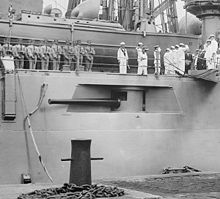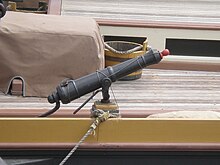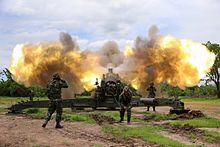Weapon mount
This articleneeds additional citations forverification.(June 2022) |
Aweapon mountis an assembly ormechanismused to hold aweapon(typically agun) onto aplatformin order for it to function at maximum capacity. Weapon mounts can be broken down into two categories: static mounts and non-static mounts.
Static mount
[edit]
Astatic mountis a non-portable weapon support component either mounted directly to the ground, on a fortification, or as part of a vehicle.
Turret
[edit]Agun turretprotects the crew or mechanism of a weapon and at the same time lets the weapon be aimed and fired in many directions.
A turret is a rotating weapon platform, strictly one that crosses the armour of whatever it is mounted on with a structure called a barbette (on ships) or basket (on tanks) and has a protective structure on top (gunhouse). If it has no gunhouse it is a barbette, if it has no barbette (i.e., it is mounted to the outside of the vehicle's armour) it is an installation.
Turrets are typically used to mountmachine guns,autocannonsor large-calibreguns. They may be manned or remotely controlled. A small turret, or sub-turret on a larger one, is called acupola.The termcupolaalso describes rotating turrets that carry no weapons but instead are sighting devices, as in the case oftankcommanders. Afinialis an extremely small sub-turret or sub-sub-turret mounted on a cupola turret.
Typically the gun is fixed on its horizontal axis and rotated by turning the turret, withtrunnionson the gun used to allow it to elevate. Alternatively, in anoscillating turretthe entire upper section of the turret moves to elevate and depress the gun.
Casemate
[edit]
A casemate is an armoured structure consisting of a static primary surface incorporating a limited-traverse gun mount: typically, this takes the form of either a gun mounted through a fixed armour plate (typically seen ontank destroyersandassault guns) or a mount consisting of a partial cylinder of armour "sandwiched" between plates at the top and bottom (as with the sponson guns of early tanks and the secondary armament of Dreadnought-era battleships).
Coaxial
[edit]Acoaxial mount,pioneered onT1 Light Tankin late 1920s and widely adopted by late 1930s, is mounted beside or above the primary weapon and thus points in the same general direction as the main armament, relying on the host weapon's ability to traverse in order to change arc. The termcoaxialis something of amisnomeras the arrangement is strictly speaking paraxial (i.e., parallel axes, as opposed tothe same axis), though for ballistic purposes the axis is effectively the same in practical terms.
Nearly allmain battle tanksand mostinfantry fighting vehicleshave a coaxialmachine gunmounted to fire along a parallel axis to the main gun. Coaxial weapons are usually aimed by use of the main gun control. It is usually used to engageinfantryor other "soft" targets where use of shots from the main gun would be dangerous, ineffective or wasteful.
Some weapons such as theM40 recoilless rifleand theMk 153 Shoulder-Launched Multipurpose Assault Weaponhave a smaller caliberspotting riflemounted incoaxialfashion to the barrel or launch tube. These weapons fire special cartridges designed to mimic the ballistic arc of the host weapon's ammunition, using tracer or point-detonating rounds so that a gunner can easily determine where a shot will land in order to place fire accurately. Due to the adoption of more advanced systems such as laser rangefinders, they are rarely used on modern weapons.
Ground mount
[edit]Fixed
[edit]Afixed mountis incapable of horizontal movement (traverse), though not necessarily incapable of vertical movement (elevation). The entire mounting must be moved in order to change direction of fire. Fully fixed mounts (no traverseorelevation) are most commonly found on aircraft, and most commonly direct the weapon forward, along the aircraft's vector of movement, so that a pilot can aim by pointing the nose of the aircraft at the target. Some aircraft designs used different concept of fixed mounts, as found inSchräge MusikorAC-47 Spooky.TheStridsvagn 103is an unusual turretless main battle tank with a fixed main gun that is aimed using the tank's tracks and suspension.
Military aircraft also often used fixed mounts calledhardpointsorweapon stationsto attach disposable stores such as missiles, bombs and external fuel tanks: these devices mount a standardised set of locking lugs to which many different types of armament can be affixed.
Fixed traverse mounts capable of only elevation are common on larger self-propelled guns, as well being the mounting method used by virtually all railroad guns.
Pintle
[edit]
Apintle mountis aswivelingmount that allows the gun to be freely traversed or elevated, while the base of the mount is still fixed keeping the whole system in one stable position: typically the mounting is either a rod on the underside of the gun (a pintle rod) that mates with asocket mechanism,or an intermediary cradle that mounts to the sides of the weapon's barrel or receiver. Due to the stability offered by the mount, the gun typically does not need ashoulder stock,with many modern examples using two-handed spade grips. It is most commonly found onarmoured vehicles,improvised fighting vehiclessuch astechnicals,side gun stations onWW2and earlier-erabomber aircraft,and the door guns ofarmedtransport helicopters.Early single-shot examples referred to asswivel gunswere commonly mounted on the deck rails ofnaval vesselsin theAge of Sailto deterboardersat close range.
Larger guns require a heavier mounting referred to as apedestal,and even larger guns aturntableplatform: a pedestal mount may be directly manipulated, but larger guns typically require the use of mechanical handwheels orhydraulic/electric actuatorassistance for traversing and elevation adjustments. Very large mounts might also include seats for the crew fixed to the gun cradle or the floor of the turntable.
Unlike a turret, this type of mount typically has little or no armour protection, usually at most a frontalgun shield.
Remote weapon station/installation
[edit]This is a power-assisted mounting on the outside of whatever it is mounted on, usually bolted down to the surface and with only the control wires crossing the armour. Such mountings are typically used on armoured fighting vehicles for anti-personnel weapons to avoid exposing a crewmen to return fire, and on naval vessels for self-containedCIWSsystems.
Swing arm
[edit]
Aswing mountis a fixed mount that allows a far greater and more flexible arc of fire than the simple pintle mount system. Utilising a system of one or two articulated arms the gunner can swing the weapon through a wide arc even though the gunner's position is fixed relative to the mount. These systems vary in complexity from a simple arm, to a double arm with the ability to lock the weapon in any firing position.
Non-static mount
[edit]
A mobile mount is a weapon mount that is portable or can be transported around byinfantry.
Carriage
[edit]Large weapons that cannot easily be lifted byinfantryrequire aplatformthat can be moved around whenmobilityis needed.Wheelsare typically used to allow maneuverability, althoughskidsare sometimes preferred in cold climates where icy/snowy surfaces become problematic for wheels, and some particularly heavy guns have historically used unpoweredtracks.Small carriages can be pushed/pulled by hands in the manner of a smallcartorwheelbarrow,while larger ones requiretractionby animals or vehicles. Large weapons often use a deployable base to make them easier to transport and more stable in their firing position: split-trail mounts (where two long "trails" can be brought together to make a towing bar) and cruciform bases with two folding legs are examples.
"Pack howitzers" are a special case where the carriage can be completely dismantled and split into a series of loads for transport over rough terrain, typically bymules.
Baseplate
[edit]Typically used by infantrymortars,this is a flat plate mounted to the weapon directly or using aball joint.The plate is usually square, rectangular or circular, and designed to spread out the weapon'srecoilforce to prevent it from being piledriven into the ground: it is often, though not always, used with a two-legged stand to elevate the barrel at a desired angle.
Monopod
[edit]Amonopodhas one leg and does not provide stability along thecoordinate axisof motion. Monopods have the advantage of being light and compact although when used in firing mode it does not have enough stability to be used with large firearms. Monopods are typically used on short-barreled, precision-fire firearms. Many sniper rifles feature a monopod integrated into their stock, providing the effect of a tripod when it is combined with a frontal bipod.
Bipod
[edit]Abipodhas two legs and provides stability along the left-to-rightcoordinate axisof motion.
The bipod permits the operator to rest the weapon on the ground, a low wall, or other object, reducing operator fatigue and permitting increased accuracy.
Bipods can be of fixed or adjustable length, and can either be an accessory mounted to the weapon or integral to it. Those of higher quality can be tilted and also have their tilting point close to the bore central axis, allowing the weapon to tilt left and right a small amount, allowing a quick horizontal sight picture on uneven ground and keeping the operator close to the ground.
Tripod
[edit]Atripodhas three legs and provides stability along the left-to-right and fore-and-aftcoordinate axisof motion. Tripods have the disadvantage of being heavy and bulky, but provide far superior stability and do not require the user to exert any force in order to keep the mount balanced. Tripods are typically used on support weapons such as heavy machine guns, repeating grenade launchers,recoilless riflesand large infantry anti-tank missiles systems such asBGM-71 TOW.These tripods are often much larger than the weapon itself and may have mechanical elevation and traverse controls for indirect fire.
The tripod permits the operator to rest the weapon on the ground and thus the gun feels lighter to the shooter and accuracy is increased.
Shooting saddle
[edit]
A shooting saddle typically uses atripod headbut, instead of mounting the weapon directly to the tripod, the saddle is mounted to the tripod head and the rifle is cradled within the saddle. These saddles began to appear in the late 2000s as a solution to provide a stable shooting platform for snipers and marksmen who may need to take a shot from somewhere other than the prone position. Prior to their introduction, snipers had only shooting sticks or jury-rigged setups to use.[1][2]
Fork rest/shooting sticks
[edit]
Shooting sticksare portable weapon mounts used by field shooters, like hunters,snipersandmetallic silhouette black-powder rifle shooters.They can be anything from purpose-built rests to constructions made from actual sticks, and have between one and three legs. They have existed since the days of earlyarquebusiers,when they would typically be a long thin stake with a U-shaped rest at the top, referred to as a fork rest.
Onfirearms,shooting sticks are commonly used onriflesto provide a forward rest and reduce motion. Shooting sticks permit the operator to rest the weapon on the ground, a low wall, or other object, reducing operator fatigue and permitting increased accuracy.
Underbarrel
[edit]This type of infantry weapon mount is used to mount a weapon beneath the barrel of a larger one, using either special mounting equipment or an accessory rail. This allows the user to have two weapons ready in hand and a simple change of grip is all that is needed to fire the accessory weapon. It is most commonly used to mount a single-shotgrenade launcherto a rifle or a cut-downshotgunto breach doors.
Individual
[edit]Various forms of weapon mounts have existed for individual use, or experimented with for military trials to ease the handling of heavy weapons and reduce fatigue on the battlefield. An example is theaffusto d'assalto(assault carriage) or "bari mount" that was devised by the 139° e 140° Reggimento Fanteria Brigata "Bari" in 1917 and used on theVillar Perosa aircraft submachine gunforwalking firetactics.[3]This allowed the user not only to fire the spade grip weapon but also throw grenades at the same time during combat. The Bari mount was used in trench raids, and was integral to the doctrinal purpose of the so-called 'pistollettieri' sections who were effectively grenadier-submachine gunners.
Another example is theThird Arm Weapon Interface Systemand REAPER weapon support system.
See also
[edit]References
[edit]- ^Zant, Cal (26 March 2014)."Shooting Rest: HOG Saddle & PIG Saddle Review".Precision Rifle Blog.Archived fromthe originalon 21 June 2021.Retrieved25 June2022.
- ^Ewing, Melvin (30 August 2021)."Other Product Review HOG SADDLE – FULL REVIEW".Sniper Central.Archived fromthe originalon 30 August 2021.Retrieved25 June2022.
- ^"Villar Perosa submachine gun".
